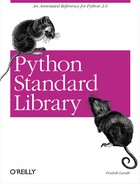The rfc822 module contains a parser for mail and news messages (and any
other messages that conform to the RFC 822 standard, such as HTTP
headers).
Basically, an RFC 822–style message consists of a number of header fields, followed by at least one blank line, and the message body itself.
For example, here’s a short mail message. The first five lines make up the message header, and the actual message (a single line, in this case) follows after an empty line:
Message-Id: <[email protected]> Date: Tue, 14 Nov 2000 14:55:07 -0500 To: "Fredrik Lundh" <[email protected]> From: Frank Subject: Re: python library book! Where is it?
Example 6-1 shows how the message parser reads the headers and returns a dictionary-like object, with the message headers as keys.
Example 6-1. Using the rfc822 Module
File: rfc822-example-1.py
import rfc822
file = open("samples/sample.eml")
message = rfc822.Message(file)
for k, v in message.items():
print k, "=", v
print len(file.read()), "bytes in body"
subject = Re: python library book!
from = "Frank" <your@editor>
message-id = <[email protected]>
to = "Fredrik Lundh" <[email protected]>
date = Tue, 14 Nov 2000 14:55:07 -0500
25 bytes in bodyThe message object also provides a couple of convenience methods, which parse address fields and dates for you, as shown in Example 6-2.
Example 6-2. Parsing Header Fields Using the rfc822 Module
File: rfc822-example-2.py
import rfc822
file = open("samples/sample.eml")
message = rfc822.Message(file)
print message.getdate("date")
print message.getaddr("from")
print message.getaddrlist("to")
(2000, 11, 14, 14, 55, 7, 0, 0, 0)
('Frank', 'your@editor')
[('Fredrik Lundh', '[email protected]')]The address fields are parsed into (mail, real name) tuples. The date
field is parsed into a 9-element time tuple, ready for use with the
time module.
